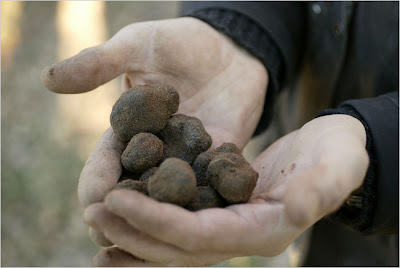Straight to the Source
By Nicholas Wade
March 28, 2010
The black truffle of Périgord, the cynosure of every foodie’s dreams, is about to yield its most intimate secrets to a team of French and Italian researchers who have decoded its genome. Surely a great day for gastronomy and yet — truffle-lovers be advised — some of the new discoveries may reveal more than you really wanted to know.
Truffles are the fruit of fungi that infect the roots of certain trees. They are of keen interest to pigs, particularly sows, because some secrete androstenol, a hormone produced by boars before mating. People who use sows to hunt for truffles often find it hard to prevent a sex-crazed animal from eating the truffle she has found and may lose fingers in the attempt.
It turns out the truffles, too, have sex lives, said Dr. Francis Martin, a plant biologist at the University of Nancy in France and leader of the research team. The precious fungi had long been thought to lead an asexual existence, but Dr. Martin and his colleagues have found that they have two sexes, or mating types.
The information is of great significance to truffle growers, whom Dr. Martin now advises to inject roots with both sexes of truffle spore. The truffle then benefits from the purpose of sex, which is of course to generate new combinations of genes and fresh diversity.
Truffle growers in France and Italy have a mixed reaction to the work of Dr. Martin’s team on the truffle’s genome. On the one hand, they “are always complaining we are not doing enough for them,” Dr. Martin said. On the other, “they don’t want us to get the magic recipe to produce truffles by the ton because then the price would go down.”
The Périgord black truffle has a large genome, made of 125 million units of DNA that contain about 7,500 genes, Dr. Martin and his colleagues reported online Sunday in the journal Nature. Figuring out what each gene does will take many years, but certain patterns of activity are evident.
Nestled underground in the roots of its oak tree host, the truffle fungus has a suite of genes for detecting light. These are either to help it avoid sunlight and stay safely beneath the earth, or to help it sense the passage of the seasons.
It has another suite of genes for exchanging nutrients with its host. The fungus earns its keep, providing more food for the oak than the tree’s roots can obtain alone.
Truffle-infected trees can often be recognized because a patch of bare earth develops around the trunk. The fungus seems to deter competitors of its tree aggressively, perhaps by producing some plant toxin. Dr. Martin has not yet identified the responsible genes. They may be hard to detect, he said, because they are probably unique to the truffle fungus.
The fungus’s major concern is to spread its spores, a matter of some technical difficulty for an organism that lives underground. So it produces the redolent odors that will compel surface dwellers of all kinds to search for it, eat it and distribute its spores after they have dined.
At the top end of this truffle food line are people, some of whom will pay as if truffles were worth their weight in gold. Such is human wickedness that fake truffles abound, some of them stained with walnut juice to resemble the Périgord black truffle.
People make secrets of the recipes for inoculating trees with spores and the location of truffle groves. They will steal each others’ trained truffle dogs. Dogs have taken over truffle detection duties from pigs because if one is trying to harvest a truffle wood discreetly without alerting the locals, it’s generally a mistake to show up walking a pig on a leash.
In the middle of the food line are boars and squirrels, driven wild by the truffle perfumes designed to mimic their own sex hormones. Dr. Martin said he had traced most of the genes whose products manufacture these chemicals.
Last, there are the truffle flies which lay their eggs in the truffle. From the fungus’s perspective, the insects are just another way of spreading its spores. So it attracts them by releasing anisole and veratrole, two insect pheromones, when the truffle has reached maturity. Truffles can often be detected by looking for congregations of truffle flies.
Don’t the fly’s eggs and larvae degrade the edibility of the truffle? It seems the opposite is the case. “If collected at late maturation stages, the truffles will likely carry eggs and larvae — adding proteins and aroma to the truffle,” Dr. Martin said.
Though the black truffle has a large genome, it has fewer genes than other fungi, possibly because it has chosen a very specialist lifestyle and so needs fewer genes than does a generalist fungus.
The regional nature of the truffle somewhat resembles that of wines. Since people of Périgord, Provence and other regions each claim their truffles are the best, Dr. Martin hopes to develop genetic methods for identifying regional varieties of truffle, so that each could have an official designation of origin similar to those that protect local wines and cheeses in France.


No comments:
Post a Comment